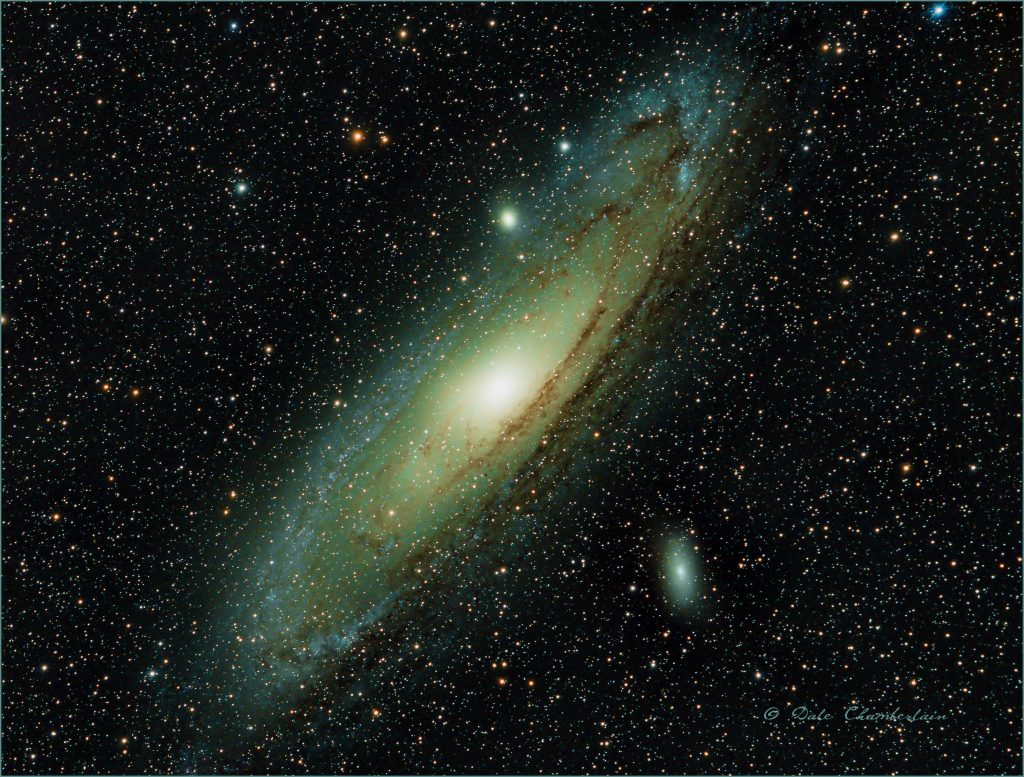
Object: The Andromeda Galaxy also known as Messier 31, M31, or NGC 224 and originally the Andromeda Nebula, is a spiral galaxy approximately 2.5 million light-years from Earth, and the nearest major galaxy to the Milky Way. The galaxy’s name stems from the area of the Earth’s sky in which it appears, the constellation of Andromeda.
The virial mass of the Andromeda Galaxy is of the same order of magnitude as that of the Milky Way, at a trillion solar masses. The mass of either galaxy is difficult to estimate with any accuracy, but it was long thought that the Andromeda Galaxy is more massive than the Milky Way by a margin of some 25% to 50%. This has been called into question by a 2018 study which cited a lower estimate on the mass of the Andromeda Galaxy, combined with preliminary reports on a 2019 study estimating a higher mass of the Milky Way. The Andromeda Galaxy has a diameter of about 220,000 light-years, making it the largest member of the Local Group at least in terms of extension, if not mass.
The number of stars contained in the Andromeda Galaxy is estimated at one trillion, or roughly twice the number estimated for the Milky Way.
The Milky Way and Andromeda galaxies are expected to collide in ~4.5 billion years, merging to form a giant elliptical galaxy or a large lenticular galaxy. With an apparent magnitude of 3.4, the Andromeda Galaxy is among the brightest of the Messier objects making it visible to the naked eye from Earth on moonless nights, even when viewed from areas with moderate light pollution.
Like the Milky Way, the Andromeda Galaxy has satellite galaxies, consisting of 14 known dwarf galaxies. The best known and most readily observed satellite galaxies are M32 and M110. Based on current evidence, it appears that M32 underwent a close encounter with the Andromeda Galaxy in the past. M32 may once have been a larger galaxy that had its stellar disk removed by M31 and underwent a sharp increase of star formation in the core region, which lasted until the relatively recent past.
M110 also appears to be interacting with the Andromeda Galaxy, and astronomers have found in the halo of the latter a stream of metal-rich stars that appear to have been stripped from these satellite galaxies. M110 does contain a dusty lane, which may indicate recent or ongoing star formation. M32 have young population as well. Messier 32 is to the left of the center, Messier 110 is to the bottom-right of the center.
Taken: September 4, 2019
Telescope: Skywatcher Esprit 80 ED Triplet APO Refractor
Mount: Paramount ME II unguided
Camera: ZWO ASI1600MC-Pro (cooled to -15C; unity gain) Bin 1×1.
Filter: Astronomik IR Blocker
Focuser: Manual
Exposures: 30×300 sec. for a total exposure time of 2.5 hours; calibrated with 100 bias frames, 25 dark frames, 32 flat frames with 32 dark-flats
Seeing Conditions:
Processed with PixInsight and Photoshop CC 2019